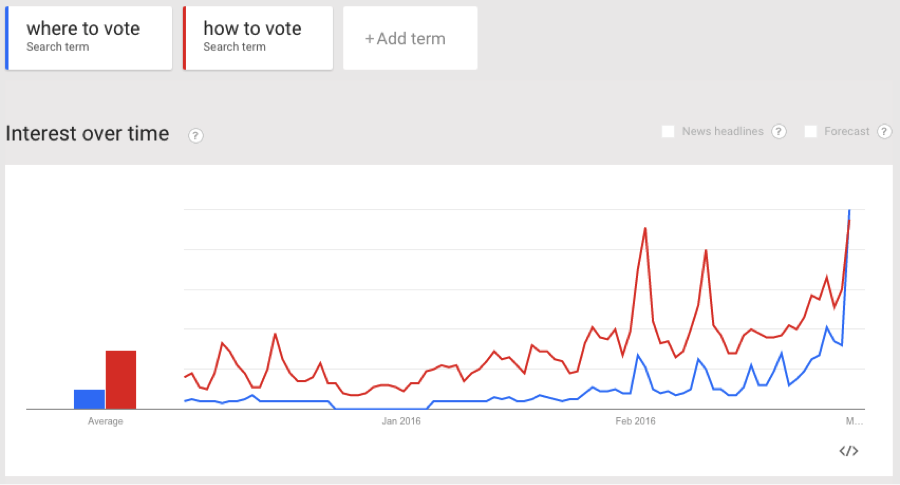It’s the season of primaries, which means there’s a mad scramble by the American people to find answers to the following queries…
- If they’re registered to vote
- Where the nearest polling place is
- What time the polling place is open
There’s nothing like a heated presidential election to spur some patriotic search behavior.
It appears that Hillary Clinton’s marketing team is tapping into our nation’s steadfast loyalty to Google in the hopes of earning some of that allegiance for herself.
Somewhere in the Hillary campaign office sits a search marketer, likely the graduate of a behemoth ad agency, who took her training on the zero moment of truth and made it work for Hillary.
As a Massachusetts resident, searches for ‘where to vote’ and all sorts of modifications (e.g. ‘where do I vote MA’, ‘voting in MA’, even ‘polling locations’) surfaced this handy little ad at the top of the Google search results page:
Here we see the beginnings of a clever and timely search campaign, courtesy of the marketing minds behind Hillary Clinton.
Through four simple steps, we see the pillars of search marketing come to life:
Step 1: Be where your audience is
Bidding on ‘where to vote’ keywords, which will generate more than 20,000 searches this month, will ensure that Hillary is the first result a searcher sees. You’ll notice that nobody else seems to be bidding on these terms.
Step 2: Focus on the searcher’s intent
Starting the ad with, ‘Find your voting location’, prioritizes the true intent of the search, leaving the ‘Hillary’ branding for the tail end.
Step 3: Provide an experience that is simple to use (and mobile friendly!)
Upon clicking the ad, you immediately get a handy piece of information: the date of your primary. And if somehow the ad got your location wrong, a dropdown on the top-right allows you to toggle to a different state.
A beaming Hillary faces the only object on the page: a simple address form awaiting your input. No crazy slogans, no campaign promises, just a form.
[Note: I tested this experience as a logged-in user to Gmail and then logged out. The only difference is that as a logged out user, the form includes a field requesting an email address. I don’t love this addition; mostly because it interrupts an experience that until this point had been purely focused on the user’s needs… but fair enough, Hillary.]
Step 4: Give the people what they want
What you get after submitting your email is a clean Google map of your polling location with the option to get directions and information about what times the polls are open.
You also have the option of emailing yourself all that good location information, looking up a new address and making a plan to vote (e.g. a message that says, “I will vote in the afternoon at XYZ location and will take public transit” will appear in your text messages).
For brands trying to understand how they can be relevant when it matters most, here’s a case study to emulate. Anticipating the moment that searches for voting information would peak in different states, Hillary’s campaign figured out a way to own a piece of the conversation.
But she could have stopped there.
Hillary could have bought that top paid ad and driven users to a simple landing page full of words of encouragement to get out and vote.
Instead, Hillary’s team created an experience that spoke to the true nature of what people came to Google for in the first place.
While the conversion rate of site visits to primary votes for Hillary is impossible to guess, she swept up in the presidential search marketing category. Judging by the MA presidential primary results, this may have been just the edge Hillary needed.
You can also learn how presidential candidates are now being given access to publish direct to Google SERPS here.
Special thanks to Cara Guappone for sharing her experience of figuring out where to vote.
The article Presidential candidates, here’s how to win (at search marketing) was first seen from https://searchenginewatch.com




No comments:
Post a Comment